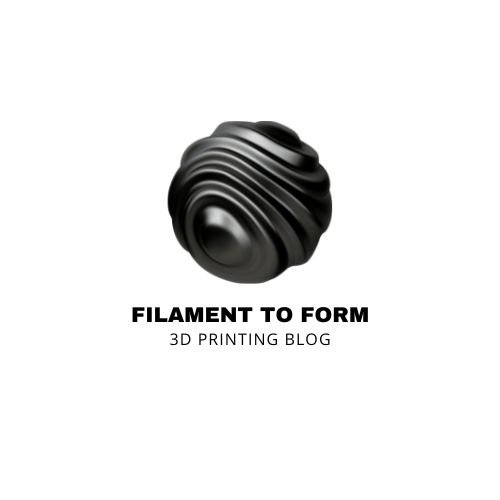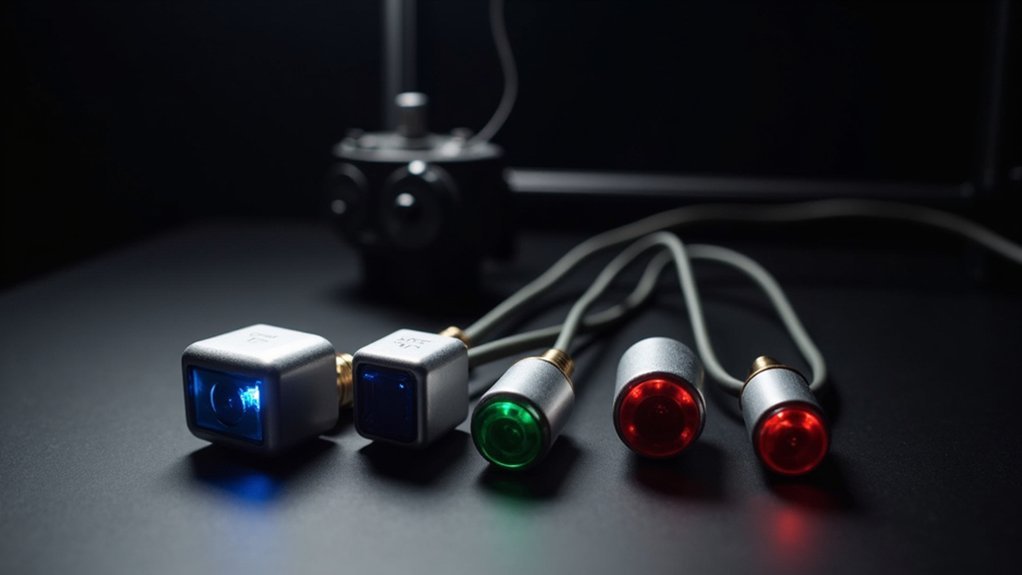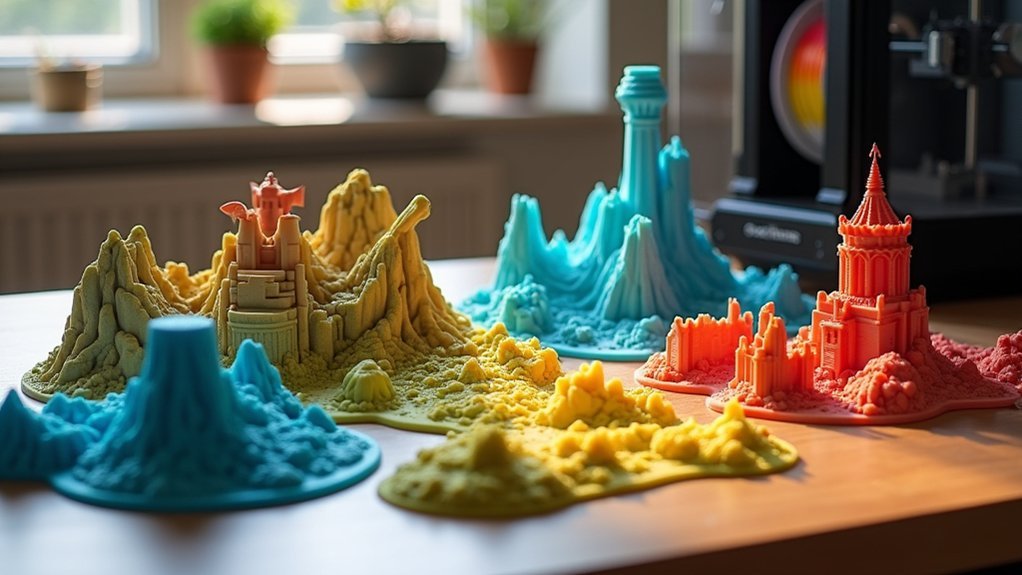You’re likely experiencing inconsistent print quality, failed prints, or warped layers because your 3D printer’s temperature isn’t properly monitored. Whether you’re dealing with hotend fluctuations, bed temperature variations, or ambient conditions affecting your prints, the right monitoring system can transform your printing success rate. From basic thermistors to extensive wireless systems, each solution addresses specific temperature challenges that could be sabotaging your projects right now.
Creality Original 3D Printer Thermistor Temp Sensor NTC100K (5 Pack)
If you’re running a Creality 3D printer and need reliable temperature monitoring, the Creality Original 3D Printer Thermistor Temp Sensor NTC100K offers precision measurement across an impressive -30°C to +300°C range. You’ll find it compatible with Ender 3 series, Ender 5 series, Ender-6, and select CR-10 models.
The single-ended glass sealed design delivers fast temperature conduction and maximum service life. You won’t need motherboard disassembly for installation—the four-step process includes waterproof hot melt glue and a tin sealing ring, eliminating soldering requirements.
Users praise its effectiveness in resolving nozzle temperature issues, though some report oil residue upon arrival. Always verify compatibility before ordering to avoid returns.
Best For: Creality 3D printer owners who need reliable temperature sensors for their Ender 3, Ender 5, Ender-6, or CR-10 series printers and want easy installation without soldering.
Pros:
- Wide temperature range (-30°C to +300°C) with fast, precise measurement capabilities
- Tool-free installation with waterproof hot melt glue and sealing ring eliminates need for soldering
- Single-ended glass sealed design ensures durability and maximum service life
Cons:
- Some units arrive with oil or lotion residue that needs cleaning
- Compatibility issues if wrong model ordered, leading to potential returns
- Limited to specific Creality printer models, not universally compatible
Ambient Weather WS-3000-X5 Thermo-Hygrometer Wireless Monitor w/ 5 Remote Sensors
The Ambient Weather WS-3000-X5 stands out as the ultimate monitoring powerhouse for 3D printing enthusiasts who need extensive environmental tracking across multiple locations. You’ll monitor temperature, humidity, dew point, and heat index across five sensors simultaneously, with expansion capability to eight units. The wireless system operates up to 300 feet from the base station, letting you track conditions in your printer room, filament storage areas, and workspace remotely. You can set customizable alarms for each sensor and export data to CSV files via micro-SD card for detailed analysis of your printing environment’s performance trends.
Best For: 3D printing enthusiasts and serious hobbyists who need comprehensive environmental monitoring across multiple locations with data logging capabilities.
Pros:
- Monitors up to 8 locations with 5 sensors included, expandable for complete workshop coverage
- Data logging to CSV files via micro-SD card enables detailed analysis of environmental trends
- Customizable alarms for each sensor with wireless range up to 300 feet for remote monitoring
Cons:
- Base unit loses all settings when unplugged, requiring complete reprogramming each time
- Remote sensor displays are faint and difficult to read in certain lighting conditions
- Limited customization options for naming individual sensors, making identification challenging
Comgrow 5PCS NTC Thermistor 100K for Creality 3D Printers
Creality 3D printer owners who frequently replace thermistors will find exceptional value in the Comgrow 5PCS NTC Thermistor 100K package. You’ll get five high-precision NTC 3950 100K ohm thermistors with 51.1-inch wire lengths and 2-pin XH2.54 female connectors. They’re compatible with Ender 3, Ender 3 Pro, Ender 3 Neo, Ender 3 Max, and Voxelab Aquila printers. You’ll appreciate their fast temperature conduction, high-temperature resistance, and reliable accuracy for both heated beds and hot ends. With 4.6 out of 5 stars from nearly 2,000 ratings, these thermistors offer straightforward installation and exceptional durability for consistent printing performance.
Best For: Creality 3D printer owners who need reliable replacement thermistors for Ender 3 series and Voxelab Aquila printers and want good value with multiple units included.
Pros:
- High precision NTC 3950 100K ohm thermistors with fast temperature conduction and excellent accuracy for consistent printing performance
- Great value package includes 5 thermistors with long 51.1-inch wire lengths and convenient 2-pin XH2.54 female connectors
- Strong customer satisfaction with 4.6 out of 5 stars from nearly 2,000 ratings and straightforward installation process
Cons:
- Limited compatibility as they don’t work with newer models like Ender 3 V2, Ender 3S, CR-10S Pro series, or Ender 6
- Some users report glass bulb size discrepancies that may require drilling for proper fit in certain printer models
- Occasional low-temperature warning issues and packaging problems during shipping reported by some customers
Resin 3D Printer Enclosure with Ventilation Kit (25.6×21.7×29.5in)
Professional makers and hobbyists working with resin 3D printers will find this extensive enclosure system delivers exceptional temperature stability alongside essential safety features. You’ll achieve precise ±1°C temperature control through sound-absorbing panels that also reduce operational noise by 33%. The built-in humidity thermometer provides real-time monitoring, preventing ABS and resin warping in challenging environments like basements or garages. You’re protected by UL94 V-0 certified flame-retardant fabric and a fiberglass frame that withstands temperatures up to 150°C. The 120CFM exhaust fan guarantees effective fume extraction, while the 16×12 PVC observation window lets you monitor prints without compromising the controlled environment.
Best For: Professional makers and hobbyists who need precise temperature control and effective fume extraction for resin 3D printing in challenging environments like basements or garages.
Pros:
- Exceptional temperature stability (±1°C) with sound-absorbing panels that reduce operational noise by 33%
- Comprehensive safety features including UL94 V-0 certified flame-retardant fabric and 150°C heat resistance
- Tool-free 5-minute setup with integrated ventilation system featuring 120CFM exhaust fan and real-time humidity monitoring
Cons:
- Large footprint (25.6×21.7×29.5 inches) may not fit in smaller workspaces
- No mention of filter replacement costs or maintenance requirements for the ventilation system
- May be overkill for casual users who only occasionally print with resin
DROK 10K Temperature Sensor Probe (5pcs 1 Meter Waterproof)
Budget-conscious makers seeking reliable temperature monitoring will find exceptional value in the DROK 10K Temperature Sensor Probe’s five-pack configuration. These waterproof NTC 10K sensors deliver precise readings from -25°C to 125°C with 1% accuracy, making them perfect for monitoring your 3D printer’s chamber temperature or heated bed zones.
You’ll appreciate the stainless steel housing’s durability and moisture resistance during extended print sessions. The 1-meter cable length provides flexible placement options, while the 2-pin JST connector guarantees easy integration with most controllers. Users consistently praise their reliability and cost-effectiveness for instrumentation projects, giving you spare sensors for future upgrades.
Best For: Budget-conscious makers and DIY enthusiasts who need reliable, waterproof temperature sensors for 3D printing, appliance repair, or instrumentation projects requiring precise monitoring from -25°C to 125°C.
Pros:
- Excellent value with 5-pack configuration providing spare sensors and 1% accuracy for precise temperature monitoring
- Durable waterproof stainless steel housing with 1-meter cable length offers flexible placement and long-term reliability
- Easy integration with standard 2-pin JST connector and proven compatibility with various appliances and controllers
Cons:
- Only available in 5-pack bundles, which may be excessive for users needing just one or two sensors
- Limited to 3-5V operating voltage range, potentially restricting compatibility with some higher voltage systems
- Requires basic wiring skills for installation and integration into existing systems
Factors to Consider When Choosing Temperature Monitoring Systems for 3D Printers
When selecting a temperature monitoring system for your 3D printer, you’ll need to evaluate several critical specifications that directly impact your printing success. Consider the temperature range requirements for your specific filaments, sensor accuracy standards, compatibility with your printer’s firmware and hardware, installation complexity level, and the system’s response time speed. These factors determine whether the monitoring system will effectively track temperature fluctuations and maintain consistent print quality throughout your projects.
Temperature Range Requirements
Since different 3D printing materials require varying temperatures, you’ll need a monitoring system that covers the full operational range of your printer. Most 3D printer applications require temperature monitoring between -30°C to +300°C to handle both hotend and heated bed operations effectively.
You should verify that your chosen system can accurately measure the extreme temperatures your specific materials demand. PLA typically requires hotend temperatures around 180-220°C, while materials like PEEK can need temperatures exceeding 400°C. Your heated bed might operate between 50-120°C depending on the filament type.
Consider the sensor’s thermal resistance capabilities for reliable performance during extended printing sessions. Systems with insufficient temperature range coverage will provide inaccurate readings, potentially causing print failures or safety hazards during operation.
Sensor Accuracy Standards
Precision becomes critical when selecting temperature sensors for your 3D printer, as even minor deviations can compromise print quality and safety. You’ll want sensors with accuracy levels of 1% or better to guarantee reliable printing outcomes. High-precision sensors provide the consistency needed for proper filament melting and bed adhesion.
Your sensor choice affects both sensitivity and response time. NTC thermistors with resistance values ranging from 10K to 100K ohms offer different performance characteristics. Higher resistance values typically provide better sensitivity but may respond slower to temperature changes.
You must calibrate your sensors regularly since ambient conditions, humidity, and installation factors can affect readings. Always review manufacturer specifications for response time and thermal conductivity to guarantee compatibility with your specific printing requirements.
Compatibility With Printer
Your printer’s hardware specifications will determine which temperature monitoring systems you can successfully integrate without costly modifications. Start by checking your printer’s model compatibility, as many sensors are designed for specific series or printer types. You’ll need to verify the thermistor’s resistance specifications—common values include 100K or 10K ohms, but your printer’s requirements may vary.
Pay close attention to connector types like 2-pin XH2.54 to guarantee they match your motherboard’s connections. The sensor’s temperature measurement range must adequately cover both your hotend and heated bed operating temperatures. Finally, prioritize systems with straightforward installation processes that won’t require extensive disassembly of your printer’s components, saving you time and potential complications.
Installation Complexity Level
While some temperature monitoring systems can be installed in minutes with simple plug-and-play connectors, others require hours of disassembly and technical expertise that might challenge even experienced users. You’ll want to prioritize systems with waterproof connectors and hot melt glue applications, as these eliminate soldering requirements and streamline the setup process. Look for sensors with pre-attached connectors that offer straightforward installation without motherboard disassembly.
Consider the positioning requirements carefully, since some systems need specific placement to avoid environmental interference, adding complexity to your setup. Always check user reviews focusing on installation experiences, as systems with poor documentation often lead to frustration and extended installation times. Clear, step-by-step instructions can make the difference between a quick upgrade and a weekend-long project.
Response Time Speed
How quickly can your temperature monitoring system detect and respond to thermal changes? Response time speed is critical for maintaining print quality and preventing defects. You’ll want sensors with response times under one second for real-time temperature adjustments to your hotend and heated bed.
NTC thermistors are excellent choices because they’re highly sensitive to temperature fluctuations, delivering fast response times that enhance reading accuracy. When your system responds quickly, you’ll avoid dangerous temperature overshoots and undershoots that cause warping, layer adhesion failures, and other print quality issues.
Always check manufacturer specifications for response time ratings when selecting your temperature monitoring system. Fast-responding sensors enable immediate corrections during printing, ensuring consistent temperatures throughout your entire print job and delivering superior results.
Environmental Protection Rating
When selecting temperature monitoring systems for your 3D printer, the environmental protection rating determines how well your sensors will withstand dust, moisture, and other contaminants that could compromise their accuracy. Look for devices with IP (Ingress Protection) codes that specify protection levels against these hazards.
You’ll want at least an IP65 rating for 3D printing applications. This guarantees your sensors are dust-tight and protected against low-pressure water jets. Higher ratings provide even better protection for extreme environments.
Understanding your sensor’s operating range and environmental resilience prevents premature failure from excessive dust or humidity exposure. While investing in systems with suitable protection ratings costs more upfront, you’ll reduce downtime and maintenance expenses long-term while guaranteeing consistent, reliable temperature readings throughout your printing operations.
Monitoring System Features
Beyond environmental durability, the core features of your temperature monitoring system will determine its effectiveness for 3D printing applications. You’ll need a wide measurement range from -30°C to +300°C to handle various printing materials and conditions. Look for systems with thermistors that deliver high precision readings and quick response times for ideal printing performance.
Data logging and graphing capabilities provide valuable insights into temperature fluctuations, helping you troubleshoot issues and enhance settings. Customizable alarms for high and low temperature thresholds let you maintain consistent conditions and prevent potential problems before they occur.
Choose systems offering easy installation and broad printer compatibility. Minimal setup requirements save time and reduce frustration during integration.
Budget and Value
Three key financial factors should guide your temperature monitoring system purchase: upfront costs, long-term value, and total ownership expenses. While you might hesitate at higher initial prices, investing in reliable systems often reduces long-term costs through fewer sensor replacements and prevented print failures.
Look for multi-sensor packages or bulk options if you’re monitoring multiple printers or different components – they’ll provide better per-unit value. Don’t overlook warranty coverage and manufacturer support, as professional assistance saves both money and troubleshooting time when issues arise.
Features like data logging and graphing capabilities can justify premium pricing by helping you optimize printing processes and identify costly inefficiencies. Calculate total ownership costs, including replacement parts and maintenance, rather than focusing solely on purchase price.
Frequently Asked Questions
How Often Should Temperature Sensors Be Calibrated for Accurate 3D Printing?
You should calibrate your temperature sensors every 3-6 months for consistent accuracy. If you’re experiencing print quality issues or notice temperature fluctuations, calibrate immediately to guarantee reliable readings and ideal printing performance.
Can I Use Multiple Temperature Monitoring Systems Simultaneously on One Printer?
You can definitely run multiple temperature monitoring systems on one printer simultaneously. They’ll provide redundant data and backup safety features. Just guarantee they don’t interfere with each other’s sensors or create electrical conflicts.
What Happens if My Temperature Sensor Fails During a Long Print Job?
If your sensor fails mid-print, you’ll likely face thermal runaway protection triggering, immediately stopping your printer. You’ll lose hours of progress, waste filament, and potentially damage your hotend or print bed from temperature fluctuations.
Are Wireless Temperature Monitors Reliable for Critical Printing Applications?
You’ll find wireless temperature monitors less reliable than wired systems for critical applications. They’re prone to interference, signal drops, and battery failures that could compromise your print’s success during important jobs.
Do Temperature Monitoring Systems Work With All 3D Printer Firmware Types?
You’ll find most temperature monitoring systems aren’t universally compatible with all firmware types. You need to check specific compatibility with Marlin, Klipper, RepRapFirmware, or others before purchasing any monitoring solution.





Leave a Reply